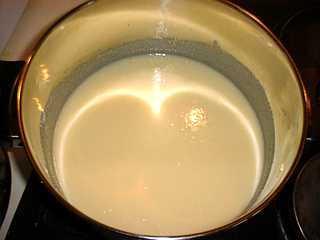 Damp the sugar with cold milk in the pan. Add the
butter and the condensed milk, and turn the heat on
medium-high.
Damp the sugar with cold milk in the pan. Add the
butter and the condensed milk, and turn the heat on
medium-high.Updated 1 January 02002
Tablet's hard to describe if you haven't had a Scottish upbringing; it's like toffee, but not chewy, it's like fudge, but more grainy. It's basically a wee bit of heaven in an otherwise dreich country. As long as you're not counting the calories.
Making tablet requires you to boil up a sugar-based mixture. Sugar boils at a much higher temperature than water, and any splashes stick to the skin and cause very painful burning. Do not attempt to make this if you are not confident with a large pan full of very hot liquid. The author of this web page can take no responsibility for your actions if you decide to follow these instructions.
Now that's over, this is my variation on my Great-Aunt Celie's tablet. Aunt Celie could make tablet so good it'd make you cry. Mine's nowhere near as good as hers, but it's good enough to be eagerly awaited by my officemates.
If you want to print this, better to download this PDF than print from MS IE.
Simple, but time-consuming: Bury a dried vanilla pod deep in a bag of sugar. After two weeks, fish the pod out. The vanilla sugar is ready; you should be able to smell the flavouring from outside the bag.
Vanilla pods, though expensive, can be reused many times. They are worth it for the subtle flavour they impart.
 Damp the sugar with cold milk in the pan. Add the
butter and the condensed milk, and turn the heat on
medium-high.
Damp the sugar with cold milk in the pan. Add the
butter and the condensed milk, and turn the heat on
medium-high.
It's an idea to put a little dollop of the uncooked mix on the spoon rest plate. I find comparing the colours of the mixture as it cooks a better way of judging readiness than using a sugar thermometer.
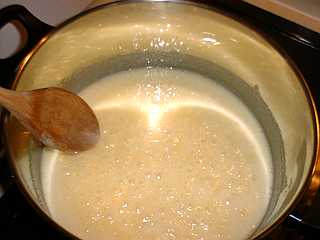 Keep stirring evenly until the mixture comes to the boil;
this usually takes about ten minutes. If you start getting
brownish streaks (caramel), turn the heat down a little, and
keep up the stirring effort. If you get black streaks, you've
burnt it. Good luck with cleaning the pan...
Keep stirring evenly until the mixture comes to the boil;
this usually takes about ten minutes. If you start getting
brownish streaks (caramel), turn the heat down a little, and
keep up the stirring effort. If you get black streaks, you've
burnt it. Good luck with cleaning the pan...
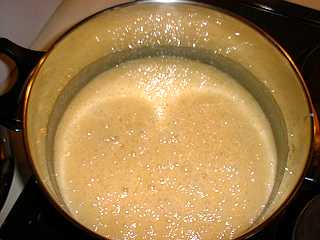 Once the mixture boils, turn the heat down low. Stir
occasionally to stop the mix sticking. When it's simmering, the
mix can be more than twice its original volume, so let's hope
you've chosen a big enough pan.
Once the mixture boils, turn the heat down low. Stir
occasionally to stop the mix sticking. When it's simmering, the
mix can be more than twice its original volume, so let's hope
you've chosen a big enough pan.
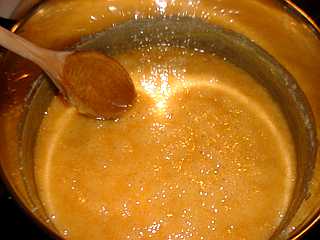 You'll
notice the mixture darken slightly; keep stirring now and
then. It'll take about 20 minutes for the mix to cook.
You'll
notice the mixture darken slightly; keep stirring now and
then. It'll take about 20 minutes for the mix to cook.
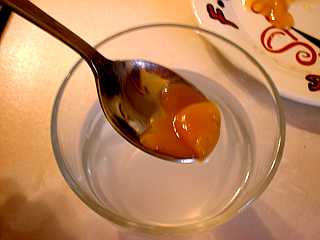 Transfer a little of the hot mix to a teaspoon, and
plunge it into cold water. It should form a soft, sticky ball
that should drip off the spoon very slowly. When it does this,
it's ready.
Transfer a little of the hot mix to a teaspoon, and
plunge it into cold water. It should form a soft, sticky ball
that should drip off the spoon very slowly. When it does this,
it's ready.
(I'd like to add that the goo on the spoon is very tasty, but be advised that it keeps its heat inside the glob. You can burn your tongue quite remarkably. Beware!)
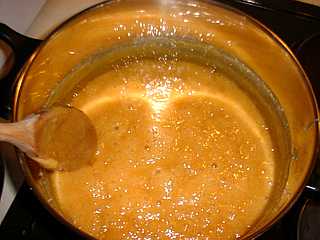 Ready! I
like my tablet a light colour, so it's usually done in twenty
minutes or less (this took 18 from coming to the boil). If you
prefer a stronger flavour, simmer for longer.
Ready! I
like my tablet a light colour, so it's usually done in twenty
minutes or less (this took 18 from coming to the boil). If you
prefer a stronger flavour, simmer for longer.
Now comes the difficult bit. Take the pan off the heat, and start stirring vigorously. Try to mix in some of the crystallized mixture that has formed on the side of the pan; what we're trying to do is to get the mixture to form large enough crystals that it will set, but small enough crystals that it will still pour. Once you feel the spoon stirring slightly grittily on the base of the pan, and the mixture being slightly stiffer, it's ready to pour.
The above is much harder to explain than to do; you'll know it when you feel the change. Of course, let it set too long or too fast, and you'll end up with a trayful of gritty lumps looking alarmingly similar to a cat box.
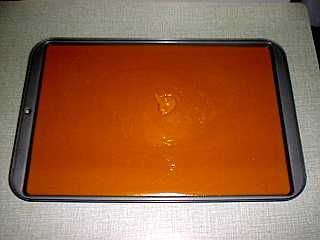 Quickly pour the mixture
into the buttered baking tray, which should be on a
heat-resistant surface. Scrape out as much of the mixture as you
can, as it will set in the pan to concrete hardness, and someone
will just have to eat what's left in there.
Quickly pour the mixture
into the buttered baking tray, which should be on a
heat-resistant surface. Scrape out as much of the mixture as you
can, as it will set in the pan to concrete hardness, and someone
will just have to eat what's left in there.
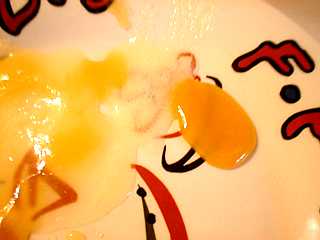 Here's the colour change, from uncooked mixture
(cream coloured, in the middle -- almost the same colour as the
plate) to the final colour, which is a golden fawn brown.
Here's the colour change, from uncooked mixture
(cream coloured, in the middle -- almost the same colour as the
plate) to the final colour, which is a golden fawn brown.
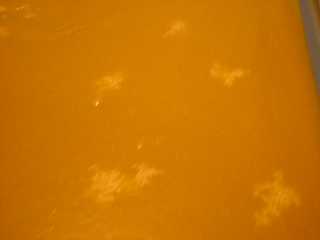 Don't be alarmed
if you see little crazed patterns appearing on the surface as the
tablet cools. It's just the sugar crystallizing.
Don't be alarmed
if you see little crazed patterns appearing on the surface as the
tablet cools. It's just the sugar crystallizing.
Once the mixture has fully cooled and set (usually overnight, if you can keep your paws off it that long), slice into bars or small chunks, and give it to your friends. If they weren't your friends before you gave them tablet, they will be afterwards.
© 02001 Stewart C. Russell <scruss@bigfoot.com> Not part of a calorie-controlled diet.